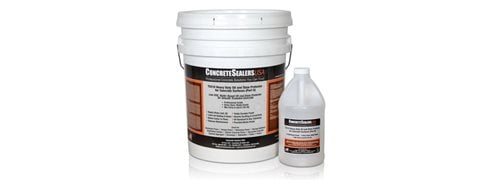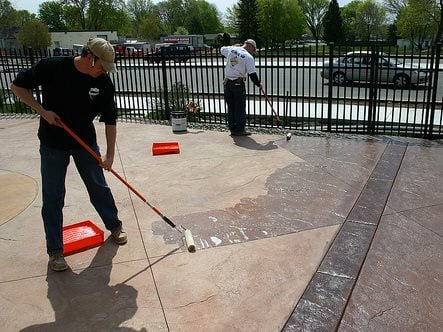- Concrete Sealer
- Comparison Chart of Concrete Sealers
- Buying Tips for Concrete Sealer Products
- Concrete Sealer Reviews: Sealer products other contractors use and recommend
- Common Questions about Concrete Sealers
- How to Remove Concrete Sealer
- Types of Sealers
- Acrylic Sealers
- Epoxy Sealers
- Penetrating Sealers
- Polyurethane Sealers
- Polyaspartic Sealers
- Application Surface
- Driveway Sealer
- Patio Sealer
- Pool Deck Sealer
- Sealers for Stamped Concrete
- Concrete Floor Sealers
- Concrete Countertop Sealers
- Pool Deck Sealer
- Exposed Aggregate Sealer
Sealer Selection & Application Advice
CAN YOU PUT SOLVENT BASED SEALER OVER WATER BASED?
Question:
I had a stamped concrete patio poured last July. The contractor sealed it with a water-based acrylic sealer. It seems from what I have read on The Concrete Network that a solvent-based product might have been better. Can I go back now and seal over the existing water-based sealer with a solvent-based sealer?
Learn more about sealers for stamped concrete.
Answer:
In general, putting a solvent-based sealer on top of a water-based sealer is a bad idea. The solvents can eat or soften the existing water-based sealer, destroying both coatings. Think of it along the lines of oil and water; they do not mix.
There is nothing wrong with water-based sealers. They tend to have low gloss levels (matte to stain) and do not darken the surface as much solvent-based sealers do. I suggest that you perform a scratch test to see how well the sealer is adhering to the concrete. (See How to Test Sealers for Adhesion). If you have good adhesion, you can reseal with the same water-based system when the time comes. If you do want to switch to a solvent-based sealer, you will need to chemically strip off the existing water-based sealer before applying the solvent-based product.
CAN YOU TINT CONCRETE SEALER?
Question:
I have recently heard a lot about tinted sealers. What exactly are they, and how and where do I use them?
Answer:
Tinted sealers provide all the benefits of a sealer along with a low dose color. Both solvent- and water-based sealers can be tinted, depending on what you are trying to accomplish. Some manufacturers offer pretinted sealers, while others provide tint concentrates in a wide array of colors that you can add to a clear sealer at the jobsite. These tints are finely dispersed metallic-based pigments in water.
Some of the first-generation tinted sealers were water-based colored curing compounds. These colored curing compounds are still available and are used most often as a matching cure for colored concrete. Another common application for colored curing compounds is revitalizing old or discolored colored concrete. Most colored curing compounds produce a fairly opaque finish, with limited translucency.
Tinted sealers, on the other hand, produce more subtle semi-translucent color effects. Water-based tinted sealers, which don't have the body to hold much color, are more translucent than solvent-based tinted sealers. Method of application is also important. When using a water-based tinted sealer, avoid spraying because the pressure and spray tip can cause the pigment to separate from the sealer.
Tinted sealers can be used as a stand-alone, low-cost decorative finish or as a method for blending and enhancing decorative jobs where the color is not quite right. No matter the application, always test or sample tinted sealers to ensure the proper color, level of gloss, and translucency. Also remember that sealers, colored or otherwise, don't last forever. Offering a client a tinted sealer often means getting them involved in a maintenance program for the life of the floor or sealed surface.
 D-One Penetrating Sealer
Non-yellowing, low sheen, good adhesion
D-One Penetrating Sealer
Non-yellowing, low sheen, good adhesion
 Deep Penetrating Sealer
RadonSeal - Waterproofs & strengthens.
Deep Penetrating Sealer
RadonSeal - Waterproofs & strengthens.
 Clear-Seal by Increte Systems
Seals and protects decorative surfaces.
Clear-Seal by Increte Systems
Seals and protects decorative surfaces.
 Heavy Duty Oil & Stain Protector
TS210 - 4 gal. kit ($439.95)
Heavy Duty Oil & Stain Protector
TS210 - 4 gal. kit ($439.95)
 Gem-Guard SB
Penetrating sealer that protects against salt damage
Gem-Guard SB
Penetrating sealer that protects against salt damage
 Decorative Sealers
Reactive and penetrating formulas in various levels of gloss.
Decorative Sealers
Reactive and penetrating formulas in various levels of gloss.
 Water Repellent Penetrating
Sealer for driveways, parking structures, plazas, walkways & more.
Water Repellent Penetrating
Sealer for driveways, parking structures, plazas, walkways & more.
 Clear Acrylic Concrete Sealer
$219.30 (5 gal.)
Clear Acrylic Concrete Sealer
$219.30 (5 gal.)
 Colored Concrete Sealer X-4
High gloss finish available in 20 colors
Colored Concrete Sealer X-4
High gloss finish available in 20 colors
COLD WEATHER SEALING BASICS
Question:
Are there general guidelines I need to be aware of when sealing exterior concrete in colder temperatures?
Answer:
As a general rule, 50 degrees F is the minimum ambient air and surface temperature needed when applying most concrete sealers and coatings. For the rest of the answer, read Sealing Concrete in Cold Weather.
HOT WEATHER SEALING BASICS
Question:
When the weather is hot, what should I watch out for when sealing exterior decorative concrete to prevent problems?
Answer:
Most one-part sealers used to beautify and protect decorative concrete work on the principle of evaporative curing. The liquid portion of the sealer evaporates, leaving the solid plastic resin to form a hard, clear film on the surface. As the surface temperature increases, the rate of evaporation increases. This is especially true when dealing with solvent-based sealers. The typical recommended surface temperature range for sealing is 50 F to 90 F. Consult the technical guidelines for the specific sealer you use, since some of the VOC-exempt solvents being used these days evaporate VERY fast.
Even though surface temperature is the key factor, don't forget to consider air temperature. If the air temperature is in the 90s, the sealer will flash cure, causing spider webbing or bubbles, no matter what the surface temperature is. Common sense would dictate that during the hot months, avoid sealing during the heat of the day.
HOW TO PICK THE RIGHT SEALER
Question:
How do I choose the best sealer to use for a particular project?
Answer:
To single out the system that meets the demands of your project, just remember the acronym SAP:
Safety - Make sure the sealer does not increase slip potential or emit harmful fumes during application, especially on indoor projects.
Appearance - Sealers come in various sheen levels, ranging from satin to glossy. The higher the gloss level, the greater the degree of color enrichment.
Performance - Sealer application thickness, durability, weather resistance, and maintenance requirements vary among the different products. Choose a sealer that will protect your concrete from the traffic conditions and elements to which it will be exposed. Also make sure the system is compatible with whatever decorative surface treatment you may be applying it to, such as an overlay or topically applied color.
Notice how cost is not one of the factors. When it comes to sealers, you really do get what you pay for. Save now, pay later is often the result for going cheap!
THE BENEFITS OF HIGH-SPEED BUFFING OF FINISH COATS
Question:
Will there be a difference in gloss and durability when applying finish coatings with a high-speed buffer instead of a roller or mop?
Answer:
If you want the optimum performance and gloss from a finish coating, applying it with a high-speed applicator (a machine with a rotary head that spins at a minimum of 2,000 rpm) is the way to go. Here's why: Most commercial-grade finish coatings used on interior decorative concrete floors are wax-modified acrylics-a blend of mostly hard acrylic with a smaller portion of softer wax. When a sealer or finish coating is applied, the solids cross link to form a film. The greater the amount of cross linking, the harder and desnser the coating. If a finish coating is applied with a roller, lamb's wool applicator, or mop, the film that forms exhibits minimal cross linking. When the finish is applied by a high-speed applicator or burnishing applicator, the heat generated actually melts the wax resin, which results in better cross linking, a tighter surface film, and a deeper level of gloss (known as "thermo-gloss").
DOES THE VOC CONTENT MEET THE CURRENT FEDERAL AND LOCAL REGULATIONS?
Question:
I have heard that the VOC regulations are changing. How will this affect the use of solvent-based sealers in the United States?
Answer:
VOCs (or volatile organic compounds) are carbon-based compounds released from solvents and plastics that form ozone and adversely impact the environment and atmosphere. The federal government as well as state and local agencies have mandated certain maximum VOC contents that particular products are permitted to contain. In regard to sealers for concrete, certain states default to the federal mandates while some set their own. To complicate things further, certain counties and "air-management districts" have set their own maximum VOC levels.
In 2006, the federal maximum VOC content for concrete sealers remains at 680 grams per liter (g/L). This allows most one-part solvent-based acrylic sealers with a solids content of 25% or more to meet federal VOC guidelines. On January 1, 2005, seven northeastern states (New York, New Jersey, Pennsylvania, Maryland, Delaware, District of Columbia, and Virginia) lowered their maximum VOC content regulations to 400 g/L. This dramatically limits the solvent-based sealers that can be used in these states. In 2006, the South Coast Air Management District governing Los Angeles and Orange Counties in California is lowering the maximum VOC content to 100 g/L. This essentially prohibits the use of any solvent-based concrete sealer in those two counties. Other air districts in California are considering the 100 g/L limit, which could take effect as soon as 2007. While many states have relatively loose VOC regulations compared with California, I would suggest starting to think about using water-based sealers in the future.
It's important to note that not all solvent-based sealers contain the same amount of VOCs. For example, xylene is a common solvent found in concrete sealers and produces VOCs, while acetone, another common solvent found in concrete sealers, is considered an exempt solvent and produces no VOCs. The other key factor is solids content. The higher the solid-resin content, the lower the liquid solvent and VOC content.
You can find out the solids and VOC content for the sealer you use by looking at the MSDS or specification sheet for the product. For more information on solvents and VOC regulations, check out these two resources from the American Chemistry Council: Solvents: Regulatory Information and Cutting Through the Maze of Clean Air Regulations: A Guide for Solvent Users.
SEALERS PERFORM DIFFERENTLY, WHY?
Question:
On a recent stained concrete project, some areas of the floor were sealed with a two-part polyurethane sealer, while other areas of the same floor where sealed with a solvent-based acrylic sealer. Why did the two-part polyurethane peel off, while the one-part solvent-based acrylic is still down and performing great? The surface has a hard-troweled machine finish, and no additional surface prep was completed prior to staining or sealing.
Answer:
This is a case of chemical versus mechanical bonding and solids content. Two-part polyurethane sealers form only a mechanical bond with concrete. This is why profiling the surface - creating more surface roughness - is always called for when working with two-part polyurethane sealers.
The same reason two-part polyurethane sealers don't chemically bond to concrete is also what makes them such good sealers. They don't chemically stick to anything, and nothing chemically sticks to them, including oil, gas, solvents, water, dirt, and graffiti.
The other major factor is solids content. Most two-part polyurethane sealers are high in solids, above 55%. The higher solids content makes them less able to penetrate the concrete surface, thus requiring additional surface profiling to promote adhesion.
Conversely, one-part acrylics bond both mechanically and chemically with concrete and are lower in solids — typically 20% to 30%. They tend to wet out faster, even on hard-troweled surfaces. As illustrated by the case in question, an acrylic sealer may chemically bond to a hard-troweled surface, but the surface won't have sufficient profile, or roughness, to mechanically bond with a high-solids polyurethane sealer.
Most manufacturers of high-solids sealers require a well-defined profile before application of their products. The use of a primer or diluting the first coat of sealer are also common methods for promoting sealer adhesion on denser surfaces. Before applying a high-solids sealer, be sure to consult with the manufacturer and perform an on-site adhesion test.
Return to Concrete Sealer Q&As





